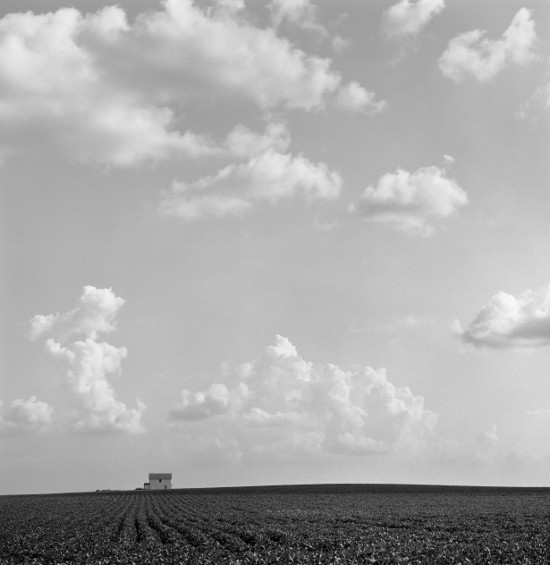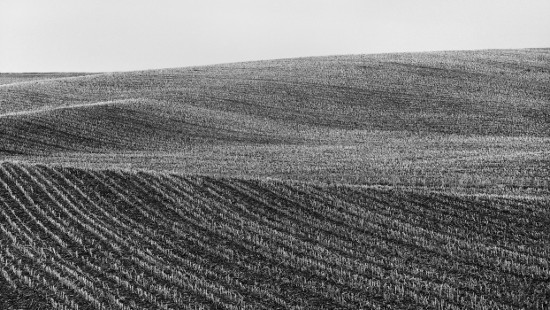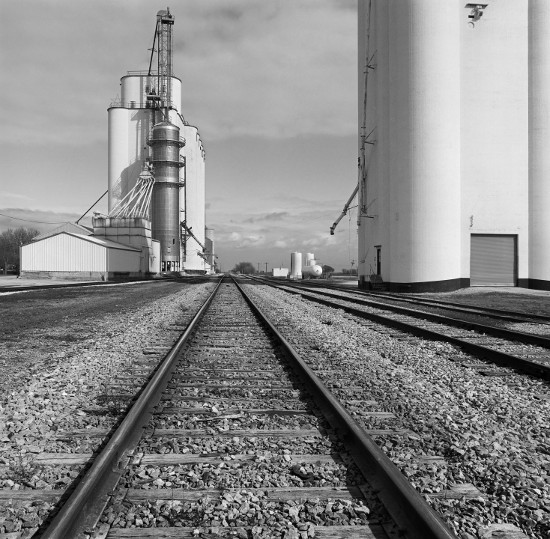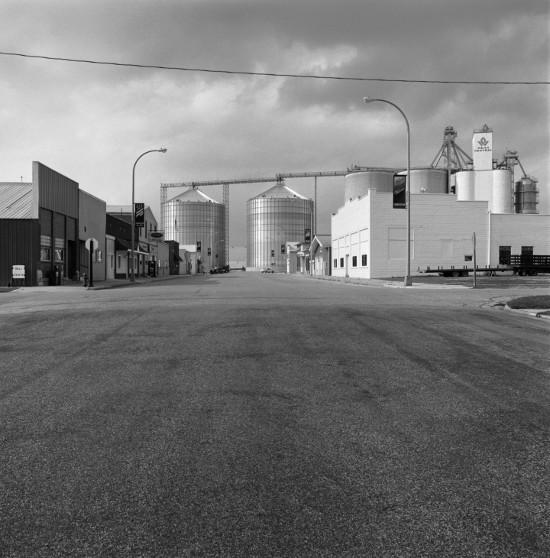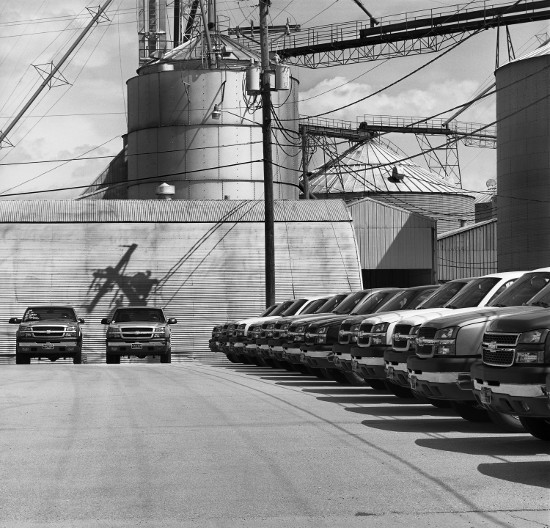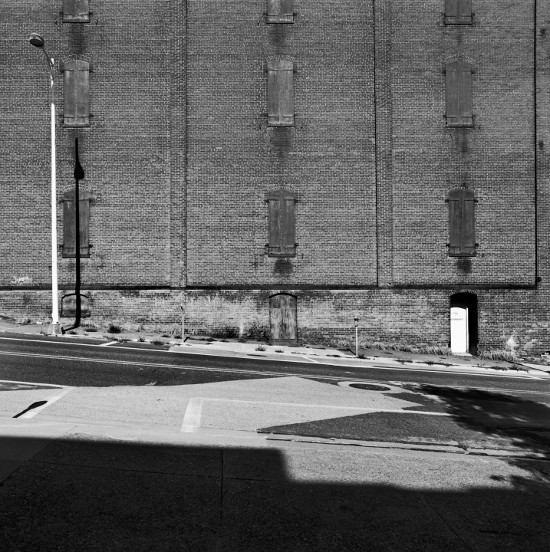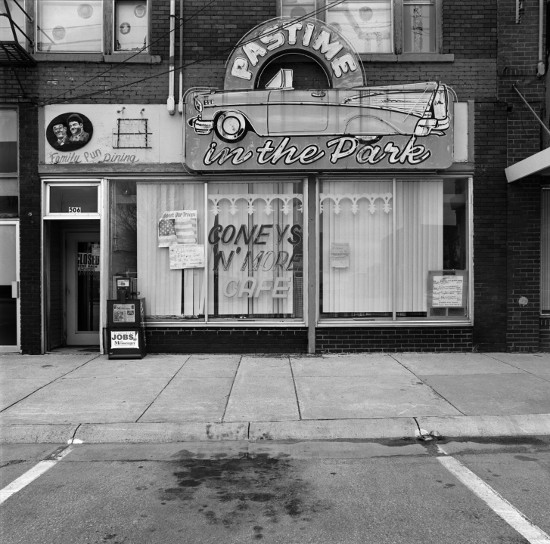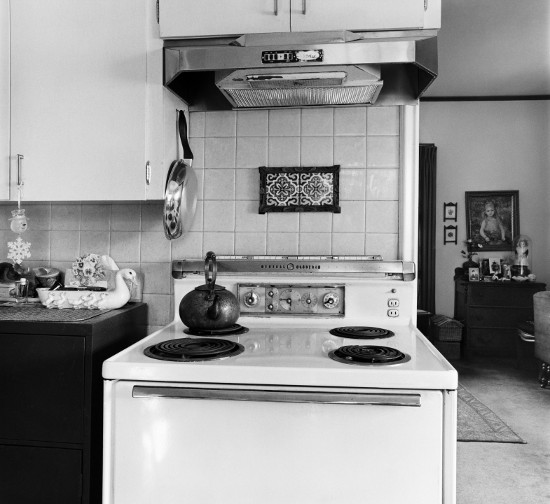Iowa is hardly renowned for dramatic landscape or architecture. One can drive for miles with no sign of life other than a road and a tilled field.
Bean Field & House, Grundy County, Iowa 2003 by photographer David Plowden dramatically depicts such a bare scene. Roughly 80 percent of the composition is sky, with sparse, fluffy clouds. At the bottom is a strip of dark land, with rows of crops running to the horizon. On the left side is a boxy house, which becomes an interesting subject when framed by the immense sky. The lines of beans bring the viewers' eyes upward, emphasizing the void. The tininess of the house in the picture makes the viewer feel diminutive.
Plowden's composition illustrates that the beauty of Midwestern scenery often lies in its grand simplicity, and how that alters the sense of scale. The stark flatness of the land, only occasionally punctuated by trees or farm buildings, shifts our field of vision; the sky begins to seems bigger, and everything on the ground becomes smaller.
David Plowden's Iowa (at the Figge Art Museum through August 26) masterfully captures the scale-warping effects of the landscape, and the photographer's 47 images of rural and small-town Iowa ably document the Midwestern agricultural aesthetic.
But he also manipulates and confuses viewers' perceptions - of size, distance, plainness, and even time - through artistic tools such as juxtaposition, viewing angle, and lack of context.
Poweshiek County, Iowa 1986 demonstrates how the absence of contextual clues, such as houses or trees, can create a subtly unsettling disruption. Unlike Bean Field & House, this photograph is mostly gently rolling hills with a thin strip of cloudless sky at the top. The precise rows of crops accentuate the topography and create a sense of motion. Plowden sets up a Z-shaped composition to keep our eyes moving along the hills: We enter at the top left to follow along the horizon, then swoop down the hill to the left, then reverse to follow the crop rows out the bottom right corner.
Architecture is also used to explore physical scale, and to highlight the significance of agriculture in Iowa. In Grain Elevators, Manson, Iowa 2004, the extreme one-point perspective of receding railroad tracks, framed by towering grain elevators, gives a sense of purpose, as we visually head toward the horizon. The elevators lack the architectural frills of skyscrapers, and thus seem ultra-modern in their simplicity and functionality. Gravel takes the place of grass along the tracks, and there are only sparse trees in the background. Without humans or prominent plants, the scene seems lifeless, but the composition suggests objective-based potential.
Templeton, Iowa 2008 demonstrates how agricultural manufacturing can dominate a landscape. Quaint downtown buildings are dwarfed by nearby grain silos, and Plowden chose a low camera angle, so the collection of buildings creates a horizontal swath through the center of the photograph. The perceived vanishing point, to which the buildings' facades aim, is a pair of shiny silver silos, creating a focal point; the commercial downtown thus seems insignificant, visually and conceptually. The old-fashioned appearance of the buildings, with only the new silos and two streetlights to give a sense of modernity, shows how context impacts our reading of time as well as space.
Keota, Iowa 2004 offers the more modern face of agribusiness in an image of a processing facility. The recognizable form of the grain silo and the barn-like facades of the buildings in the background are contrasted with criss-crossing wires and a long line of parked pickup trucks. Plowden makes wise use of repetition, with the wires and trucks balanced by the large, flat areas of the pavement, the blank building sides, and the sky. Keota matches the no-frills agricultural aesthetic with complex mechanization.
Plowden's subjects include the architecture of semi-urban Iowa, as well. Factory Building, Muscatine, Iowa 2003 shows how structures conform to the landscape near the Mississippi, with the factory building planted on a sloping hill street. The cropping of the image, with no visible sky or horizon, makes the composition feel anxious, enhanced by the dark shadows cast by the buildings and tree behind the camera. This also provides no clue about the full size of the building, and the removal of spatial and functional context creates an abstraction of a normally recognizable subject.
This composition makes the building seem important - sturdy and strong - and suggests the power of industry. But the windows are boarded up, and the parking spaces on the street sit empty. Patches of weeds grow up through the cracks in the pavement. The photograph captures the simultaneous historical beauty and dereliction of many post-industrial downtowns.
David Plowden's Iowa also includes photographs of interiors and storefronts, especially those seeming out-of-time. Coneys N'More Cafe, Fort Dodge, Iowa 2004 shows a diner entrance, with hand-painted window lettering and a large, light-up sign featuring a retro convertible. The scene appears to have not changed since the 1950s. The only indications that this photograph was taken in the past decade are the newspaper box and the overlapping oil stains in the parking spots.
Plowden explores this timeless quality in domestic spaces, too. In Beltz House Kitchen, Jefferson Township, Greene County, Iowa 2009, we see a kitchen with its original fixtures. Plowden focuses on the stove, placing it at the center of the composition. He again employs perspective, arranging the image so that the receding transversal lines of the stovetop and ventilation hood angle toward the center of the photo. Dizzingly, the top of the stove and the bottom of the vent are slightly askew from the true horizontal established by the cabinets and wall tiles, playing with our visualization of balance.
The conceptual interest of this straightforward view of a stove comes from reading the date of the photograph: 2009. Without even hints of the contemporary, the picture looks like it was taken decades ago, again distorting time through decontextualized objects from daily life. The black-and-white format, in this as well as his other photographs, contributes to a sense of temporal vagueness.
In all these cases, Plowden plays with our expectations. Using basic tools that contribute to our understanding of a static image, he removes or changes context to alter how we look at them. He forces us to see common subjects as powerful and significant, and gives us joy as we decipher his puzzles. Plowden's Iowa is less about what we see than subverting what we anticipate.
Michelle Garrison is a mixed-media artist who teaches art and design at Geneseo Middle School. She can be reached at michelle_m_garrison@hotmail.com.

